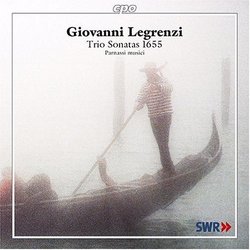Middle-Baroque composer, Giovanni Legrenzi, took a bold flye
Frank T. Manheim | Fairfax VA | 03/09/2007
(3 out of 5 stars)
"Parnassi Musici is a period instrument ensemble that draws its core musicians from the Southwest German Radio Orchestra. It has carved out a special niche for itself by performing rare, high-quality Baroque music retrieved through research in libraries and music repositories in Europe.
I'm been impressed by Parnassi's resourcefulness and taste in planning recording projects. "A little of this and a little of that" recordings definitely have their place. But there comes a time when people get seriously interested in individual Baroque composers and want substantial meals - not just hors d'ouevres.
For example, a search for Legrenzi in Amazon yielded 75 CD's but the great majority include only a single song, selection from an opera or motet, or instrumental work. The present Opus 2 set of 17 trio sonatas is striking not only in the fact that Parnassi put this collection together. Each of the short sonatas (2-6 minutes long) is named for a prominent Venetian family (e.g. La Cornara, La Spilimberga, La Strasolda, etc). This bold concept could hardly fail to attract attention, but it also carried risks. What would be the consequences in Legrenzi's relations to influential people if some pieces were more (or less) inspired than others? The daring and confident quality of Legrenzi's music is mirrored in the way he dealt with this potential problem. Each of the sonatas is distinctive stylistically. Some open with dramatic chords, others lead off with solo instruments. Unusual rhythmic devices, harmonies, or virtuosic technical displays abound - and the bass often plays a prominent role. It's often hard to believe that such advanced music was composed in 1653 - more than 50 years before Handel, Bach, and Vivaldi's earliest works. Hearing this set of sonatas, it occurred to me that Legrenzi's example might have inspired his student, Vivaldi, to likewise be bold in his own career as a composer.
Having said the above, it was disconcerting to find a serious lack of balance in the technical side of the recording. The playing is sensitive to nuances and technically virtually flawless. Sound quality is good. But the lower parts: cello, organ, or bassoon (the virtuosic baroque bassoonist, Sergio Azzolini) (not, however, the softer theorbo), are generally so loud as to completely dominate over the violin in the upper voices. One hears quite frequently the opposite problem in Baroque music recordings, i.e. flute or oboe soloists miked up so high that harpsichord - cello continuo parts become mere "background" (too soft). In this case, however, the quality we normally find in German classical recordings seems to have suffered from a lapse in attention volume balance. Maybe cello and bassoon players will applaud!
"

